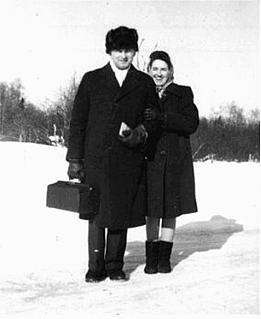Physician, Surgeon and Medical Advisor to Terry Fox
By Judith (Antonik) Harvey.
Antonik
Ladislav & Francis Anastasia
Children: Pauline, Judi, Garry, Mike, Joan.
How to sum up the life of a humanitarian and a Renaissance man? A man who was born a peasant in Slovakia, became a well-respected doctor, and died a "happy peasant" again on an island on Canada's Pacific Coast?
Getting to Canada: Ladislav was born November 24, 1919, in Bologd (Blazice), Slovakia and was the first in his village to ever attend highschool. During World War I, his father was conscripted to the Russian front. Having lived through the terrors of that war, his parents worried lest their two sons become cannon fodder for the next one. With family in mind, his father left for Canada to work in the bush camps when Ladislav was seven. When Ladislav was twelve, he recalls taking out the gun to scare off drunken louts banging on the door at night and trying to get at his mother. It would be seven long years before his father was able to pay the family's passage to Canada. On receipt of the money for the trip, it was Lad's job – now fourteen and head of the household – to get the paperwork and passports. The bureaucratic officials kept finding problems with the papers – an experience both frightening and frustrating – but he finally succeeded.
Lad emigrated to Canada in 1934 at age fifteen. The family travelled steerage and were seasick for the two-week voyage. They settled in Kapuskasing, where his father had found employment as a blacksmith with Spruce Falls. Unable to speak English (Lad learned French first), he was put in Grade 3, but advanced to high school within eighteen months. While at school he worked as a janitor, bellhop and groundskeeper for the town. He designed the school crest for Kapuskasing High and wanted to be either a painter or a doctor. Medicine won out, however, thanks to the need for doctors with the outbreak of World War II. At the time, the armed forces had a program for fast-tracking doctor training (long days, no summer holidays), so he joined up. Without this program, he would not have been able to afford medical school. He trained at Queen's University, Kingston, graduating in 1944. On that same day, he married Frances Anastasia Deir, a lovely nursing student at Hotel Dieu Hospital. He was to be sent overseas, but the war ended during his internship at Ottawa General.
Getting to Hearst: It was Dr. Penu Chalykoff who brought Lad to Hearst. He'd heard of the young Slovak doctor from northern Ontario and convinced him to join his practice. The family's first house in Hearst was an apartment over Vaillancourt's Garage; the only one available with running water.

Dr. Ladislav Antonik and Francis Antonik
As a doctor, Ladislav was one of the few entitled to a car in town, as gas was still rationed. In Hearst, he covered the bush camps, made house calls, and became a familiar figure in his long, dark wool overcoat, large black fur hat and black leather medical bag. It was not easy to get around, especially in winter. He used a snowmobile, railway pushcars (speeders), or rode the freight train in the caboose. He recalled that the French lumber camps were exciting and filled with music, but everything was stolen. At the Finnish camps, life was quiet and depressed, but nothing was ever stolen! House calls to native settlements were made by train, which the natives would flag down, before taking him the rest of the way by canoe or dog sled. On one occasion, while waiting to deliver a baby, he was so tired he climbed into the expectant women's bed and fell asleep until she was ready to deliver.
Bernard Kadnar, a displaced person (DP) from Europe after World War II, used to tell this story about Slovak friends who were driving from Kap to Hearst when someone jumped in front of their car, committing suicide. The men, all DPs and new to Canada, were terrified by all police, whom they feared would deport them. With little English, they trembled before the judge who glanced at their documents and said, "It says here you're Czechoslovakians. I want to know if you're Czechs or Slovaks?" They replied, "Slovak," at which point a voice piped up, "Ja som Slovak tez." (Me, too.) It was Ladislav, in court as coroner for the suicide fatality. "Just tell the truth," he advised, "and things will work out fine." They did.
Post-Hearst: Ladislav stayed in Hearst from 1946 until 1952. During those years, four of his five children were born. From 1952 to 1956 he studied with Dr. Wilder Penfield, at the Montreal Neurological Institute, before returning to family medicine in Kapuskasing. In 1958, he moved his family to Coquitlam, near Vancouver. In 1974, he became the medical director of the Royal Columbian Hospital in New Westminster. Here he designed the Health Care Centre (opened by Prince Phillip, in 1978) and later supervised treatment for Terry Fox. On Sunday, June 28, 1981, he made this announcement: "Terry Fox died peacefully today. He was an unusual human being who touched the hearts of millions . . . Royal Columbian Hospital deems it a great honour to have served such a great son of Canada. May he rest in peace." After retirement to Saltspring Island in 1982, Ladislav passed away in 2000.
His children all live in British Columbia. Of those born in Hearst, the eldest, Pauline, became a provincial court judge, Judi a librarian at the provincial legislature, Garry a bank manager and Mike a carpenter. Joan, who was born in Kapuskasing, became a decorator.
Can you provide corrections or comments?
Please email Ernie Bies.
Please report technical issues to:
Charlie Dobie.